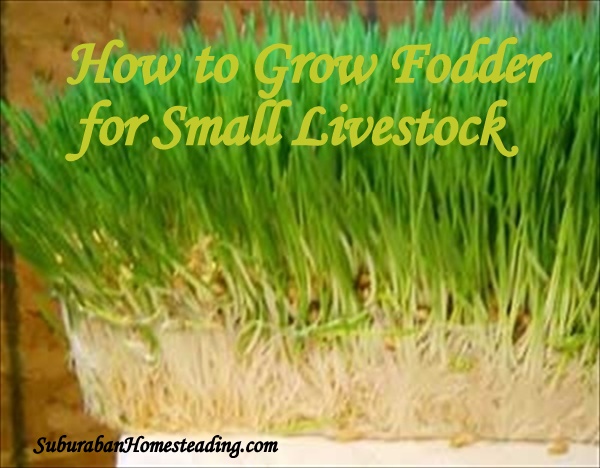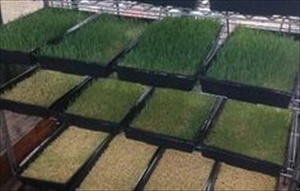How to Grow Fodder for Small Livestock
 Fodder is very similar to sprouted grains and can be used as a supplemental feed for small livestock like chickens, ducks and rabbits. It’s a wonderful nutritional supplement for areas that have harsh winters, or where good quality hay might not be easily available. The digestibility of fodder is high. That’s because the starch from the sprouted grain turns to sugar and is more usable by the animal, so less is wasted through manure. Better to feed your animals than the ground through manure…don’t ya think? Many different grains can be used to grow fodder—alfalfa, barley, clover, filed peas, oats, millet, ryegrass, sunflowers and wheat just to name a few. The best part, though… …is the whole process, from soaked grain to ready-to-feed-fodder, takes about a week. In no time at all your animals will be munching on everything from roots to sprouts. Nothing will be wasted!
Fodder is very similar to sprouted grains and can be used as a supplemental feed for small livestock like chickens, ducks and rabbits. It’s a wonderful nutritional supplement for areas that have harsh winters, or where good quality hay might not be easily available. The digestibility of fodder is high. That’s because the starch from the sprouted grain turns to sugar and is more usable by the animal, so less is wasted through manure. Better to feed your animals than the ground through manure…don’t ya think? Many different grains can be used to grow fodder—alfalfa, barley, clover, filed peas, oats, millet, ryegrass, sunflowers and wheat just to name a few. The best part, though… …is the whole process, from soaked grain to ready-to-feed-fodder, takes about a week. In no time at all your animals will be munching on everything from roots to sprouts. Nothing will be wasted!
Building Your Own Fodder System
 Commercial fodder systems can be outrageously expensive and many are too large for the small homesteader who is using fodder for supplemental feed rather than an animal’s primary feed source. But, with bit of ingenuity you can build your own system for a few dollars. You can build a simple PVC rack, buy a utility rack, find an old used wooden rack at the thrift store, or build one out of old pallets. Pallets are so useful, aren’t they? The important thing is for the growing container to fit the depth and width of the rack, so get the rack first before buying the growing containers. Any relatively shallow container will work, but it should be at least 2” deep. Vegetable seedling trays can be easily found at garden shops or purchased on-line, or plastic storage boxes will work too. Even old plastic rain gutters or large plastic pipe cut lengthwise can work. The possibilities are endless, use your imagination! When you have your growing containers drill about a dozen or so small holes evenly around the bottom. This is where having a sturdy container comes in handy. One pound of grain will produce 8 pounds of fodder so flimsy trays will crack and break after a few uses. Better to spend a bit more for longevity.
Commercial fodder systems can be outrageously expensive and many are too large for the small homesteader who is using fodder for supplemental feed rather than an animal’s primary feed source. But, with bit of ingenuity you can build your own system for a few dollars. You can build a simple PVC rack, buy a utility rack, find an old used wooden rack at the thrift store, or build one out of old pallets. Pallets are so useful, aren’t they? The important thing is for the growing container to fit the depth and width of the rack, so get the rack first before buying the growing containers. Any relatively shallow container will work, but it should be at least 2” deep. Vegetable seedling trays can be easily found at garden shops or purchased on-line, or plastic storage boxes will work too. Even old plastic rain gutters or large plastic pipe cut lengthwise can work. The possibilities are endless, use your imagination! When you have your growing containers drill about a dozen or so small holes evenly around the bottom. This is where having a sturdy container comes in handy. One pound of grain will produce 8 pounds of fodder so flimsy trays will crack and break after a few uses. Better to spend a bit more for longevity.
Now for the fun part!
Start by soaking your grain in a 5-gallon bucket for 12-24 hours. Place the grain into the bucket and fill with water. Swirl the grain around so the chaff floats to the top. The chaff won’t sprout, so just skim it off and add to the compost bin. The amount of grain you soak will depend on the number of trays you have and the amount of fodder you want to grow. Since I’m only feeding fodder to rabbits and chickens I soak 1 pound at a time. (Remember 1 pound of grain produces 8 pounds of fodder) Here’s a trick…drill a bunch of small holes (making sure the holes are smaller than the grain) in the bottom of the bucket, then set it inside another bucket before filling it with water. When the soaking is finished, simply lift out the top bucket, leaving all the water behind. After the soaking, spread the grain evenly in each tray to a depth of 2-inches; more than that can cause molding or decreased sprouting. Less than will dry out quickly and not give you a good, robust sprout. To help smooth out the grain, so it’s evenly level, use a spatula or putty knife. Place the trays on the growing rack in a sunny area or under grow lights. Grow lights work great in winter. Water each tray 2-3 times a day. The trays should be damp, but not have standing water. Some sources recommend using a catchment basin and small pump to recirculate the water through a tube back to the trays. On the surface, this sounds like a great idea—recycling water—but it can cause mold, slim and odors. Yuck! Another option is to use a 5-gallon bucket to pump clean water to the top tray and let it filter down through all the trays, before being caught at the bottom. The used water can then be used in the garden. Repeat the watering step for 7 to 9 days depending on how fast the grains sprout. Ideally, you want about 6-inches of fodder, but that will depend on temperature and water.
You’re ready to harvest!
Flip each tray over and gently pull out the fodder. You can either feed the whole thing…root mat, seeds, sprouts and ALL! Or, cut it into serving pieces with a knife or a box cutter. The root mat holds the whole thing together, like a roll of carpet. Start a new tray every day or so, so you’ll have an on-going supply of dense, rich, nutritious feed. Your animals will love you for it!
How Much Fodder Should I Feed?
For a small homestead fodder is more of a supplement of fresh, green, nutrient packed grass. It’s not meant to be the primary source of feed, especially for ruminants like sheep, goats and cattle. They will need the roughage of hay to keep their rumens working properly. Non-ruminants will also need other feed and supplements common to the species for proper growth. The list below is a good guide of how much fodder to feed, but the real test will be each animal’s physical condition. • Chicken: 2-3 % of their body weight in fodder • Rabbit: 3-5 % of their body weight in fodder • Sheep: 2-3 % of their body weight in fodder • Goat: 2-3 % of their body weight in fodder • Dairy Goat: 3-5 % of their body weight in fodder • Pig: 2-3 % of their body weight in fodder • Beef Cow: 2-3 % of their body weight in fodder • Dairy Cow: 3-5 % of their body weight in fodder • Horse: 2-3 % of their body weight in fodder
Recent comments
Aenean nonummy hendrerit mauris. Phasellus porta.